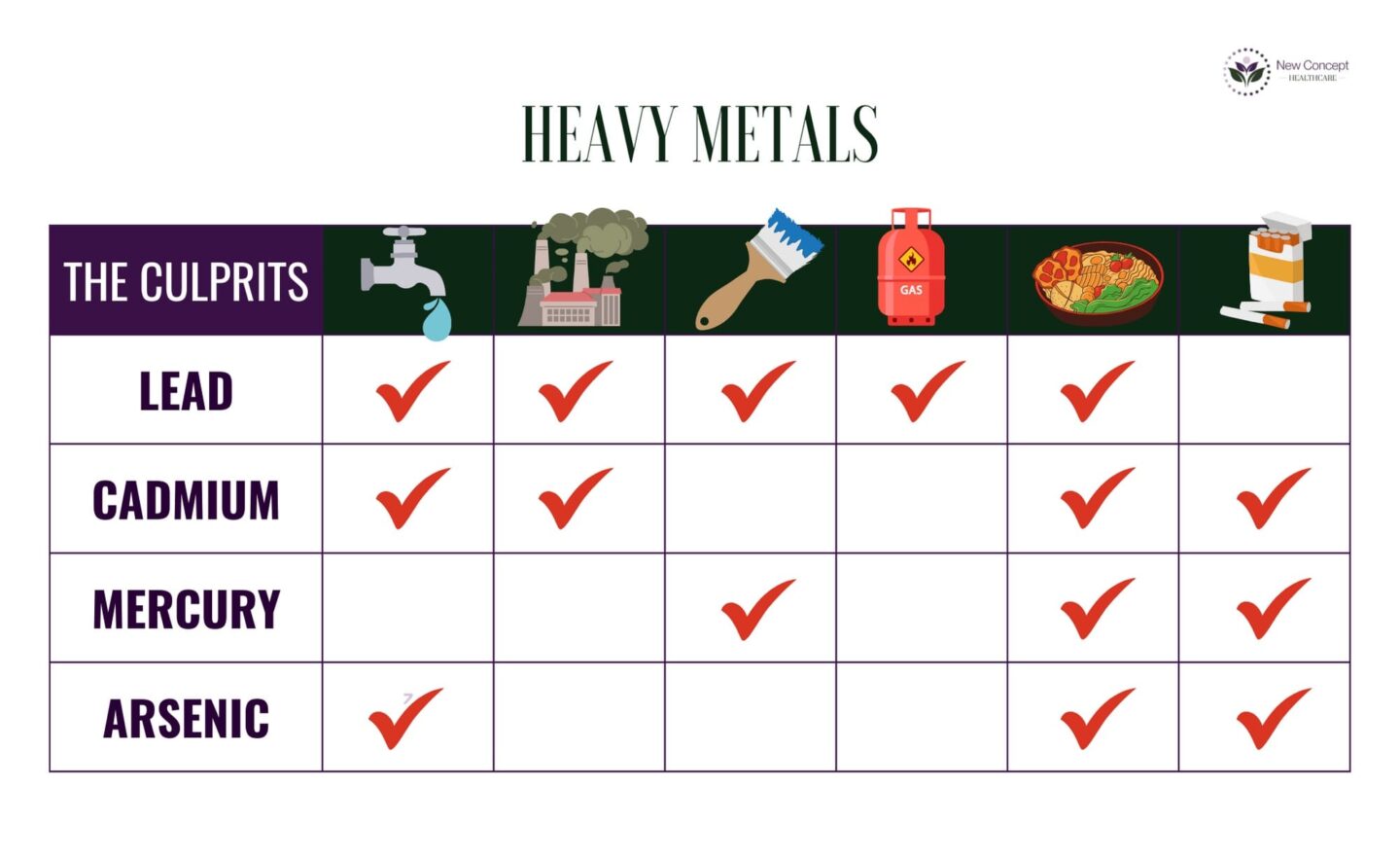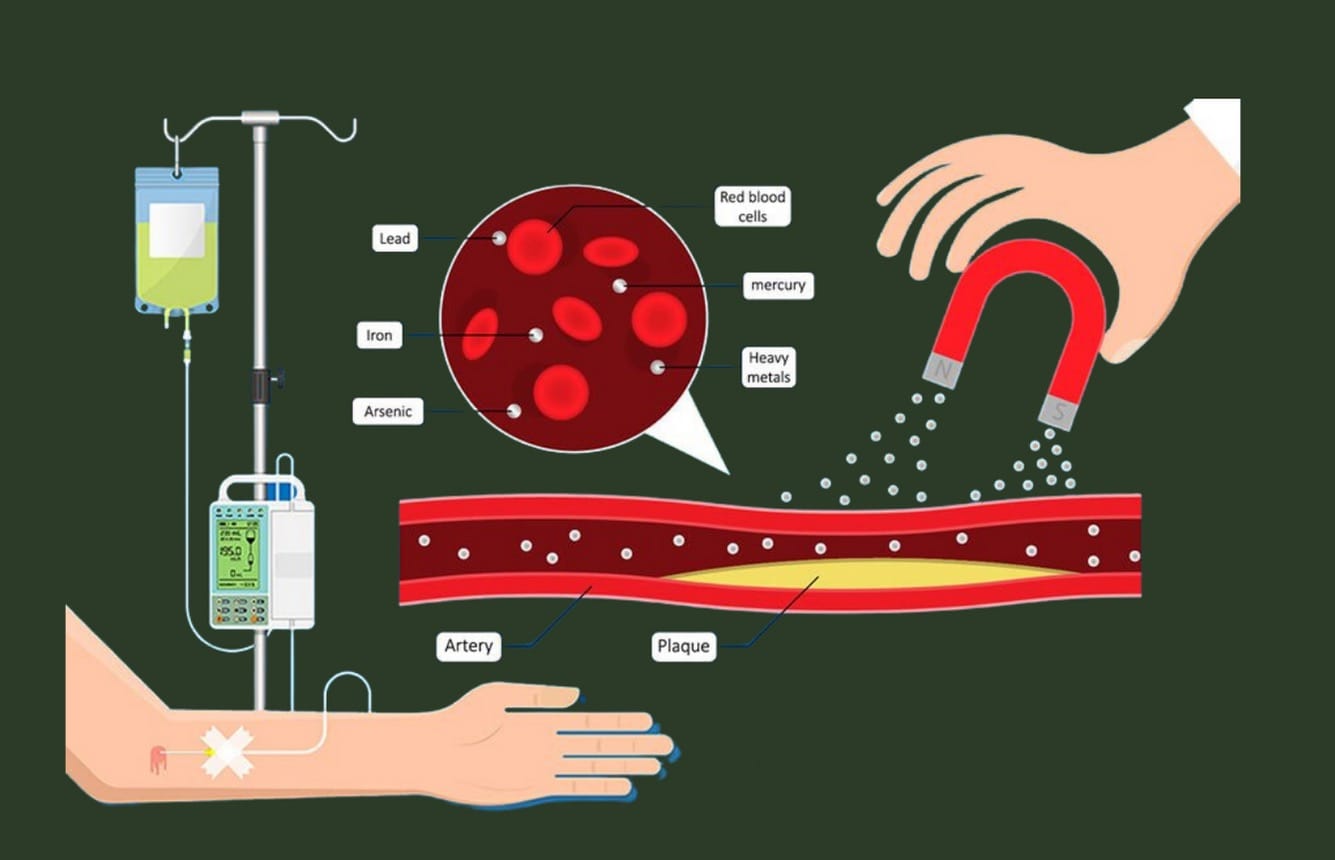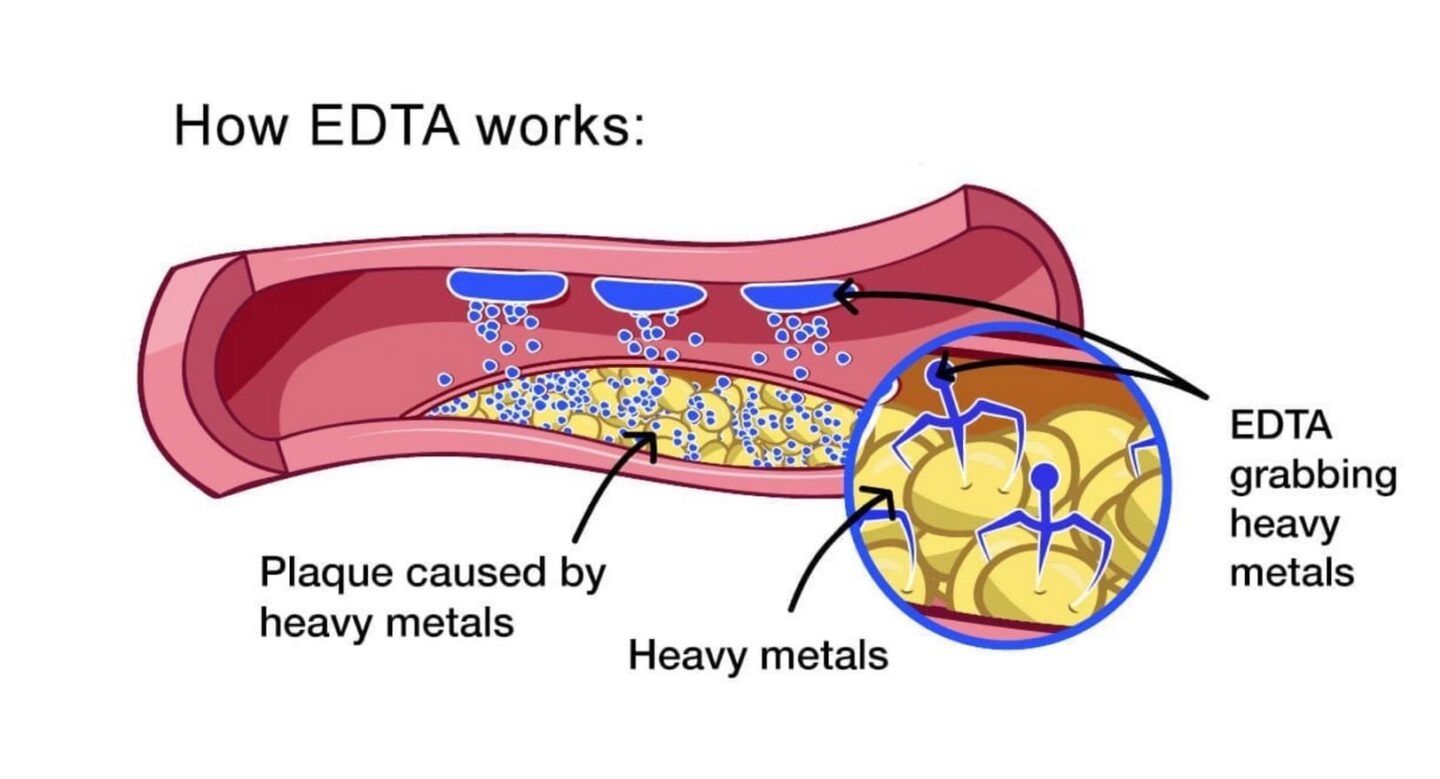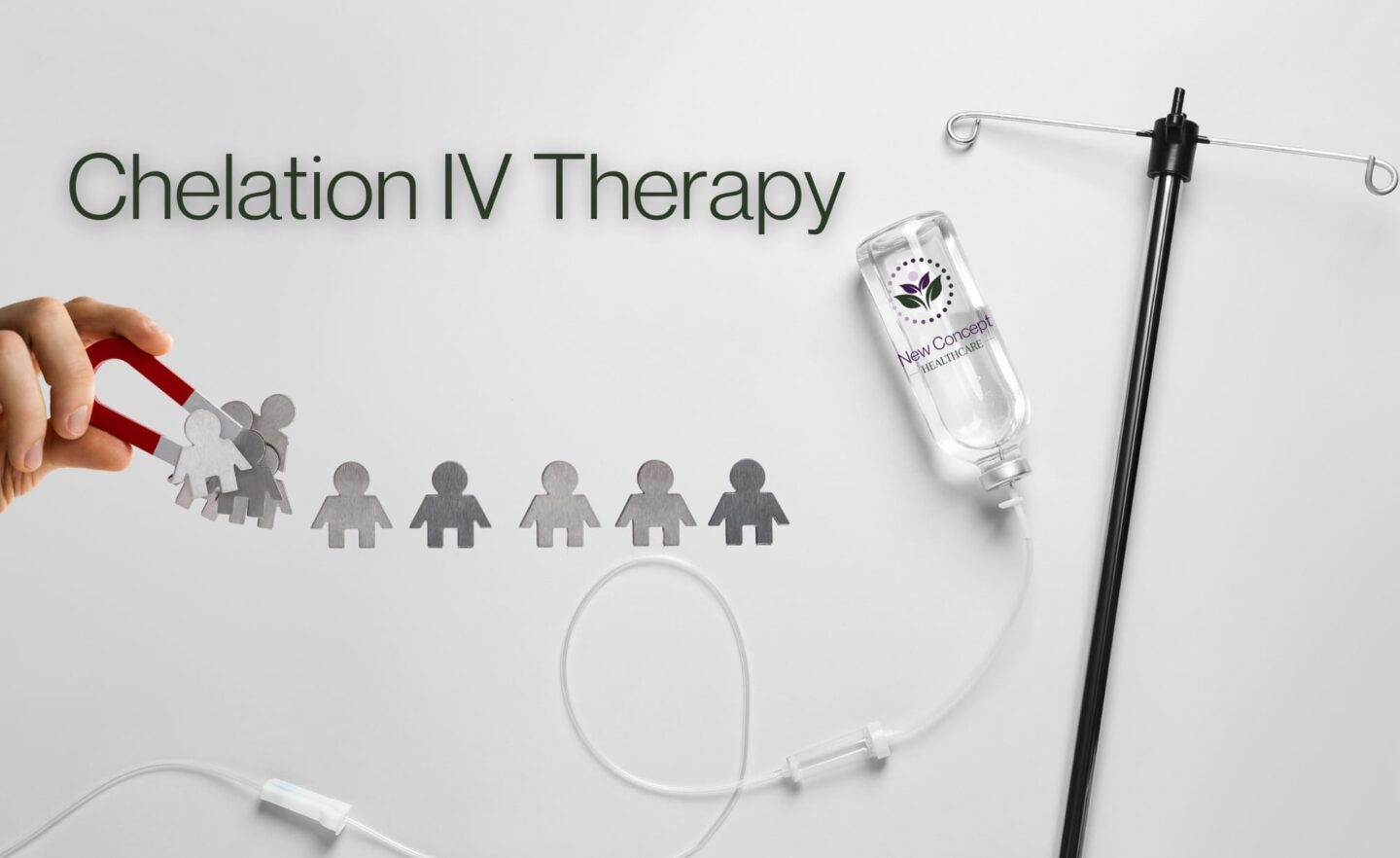Chelation IV Infusion Therapy
What are Heavy Metals New Concept Healthcare | Functional Medicine Gaffney?
Heavy metals are naturally found in our everyday environment in the soil and the air. Additionally, we are becoming more exposed to these metals due to drinking water and food crops, which are contaminated by the increased use of heavy metals in several industrial, agricultural, domestic, and technological applications. Also, those living in older homes are exposed to heavy metals from lead paint and old pipes. Toxicity occurs when levels of a heavy metal become too high. This can happen from acute high exposure or lower exposure over a long period of time.

What are some of the common Heavy Metals?
Lead
Lead accumulates over decades since the body has no natural mechanism to eliminate it. Although initially it is absorbed in the blood, it rapidly transfers into the bones and cells, where it gradually leaches out and corrodes our health, damaging arteries, the heart, and the brain. Because it may not cause any immediate symptoms, the corrosive effects can build. There, it gradually corrodes our health while damaging the brain’s arteries. Because it does not cause any immediate symptoms, these corrosive effects are slow and can take decades to appear.
Blood lead concentration correlated with all causes, all cancer, and lung cancer mortality in adults. The correlation between blood lead levels and cardiovascular mortality was observed at substantially lower blood lead levels than previously reported.
Cadmium
It was discovered in 1817 as a byproduct of the mining, smelting, and refining of zinc, lead, and copper ores. Vegetarians are at the highest risk because it is most commonly found in leafy greens, vegetables, fruits, grains, rice, seeds, potatoes, and shellfish. Cadmium is also found in tobacco, batteries, metal coatings, plastic stabilizers, and makeup. Exposure to acute and chronic Cadmium damages many organs in humans and animals, including the lungs, liver, brain, kidneys, and testes. It increases reactive oxygen species (ROS) production and causes oxidative stress. Cadmium is associated with hypertension, ischemia/perfusion, cardiovascular diseases, chronic obstructive pulmonary disease, diabetes, insulin resistance, acute respiratory distress syndrome, idiopathic pulmonary fibrosis, asthma, skin diseases, chronic kidney disease, eye diseases, and neurodegenerative diseases. Studies associate cadmium toxicity with endothelial dysfunction suggested oxidative stress as the primary mechanism for this damage. Cadmium has been designated a carcinogen by the International Agency for Research on Cancer and the United States National Toxicology Program. The carcinogenic effect is initiating cancers of the prostate, kidneys, pancreas, testicles, GI, and breast.
Mercury
Three different types are Elemental or metallic Mercury, inorganic Mercury, and organic Mercury as methyl or ethyl mercury (more toxic than inorganic Mercury). Common sources of Mercury include Methylmercury, which is found in fish secondary to pollution, dental metal fillings, some vaccines such as thimerosal and a few flu vaccines, and some cosmetics and soaps. Mercury toxicity is associated with Mees’ lines (horizontal white lines) in the nails, poor liver function such as fatty liver disease or elevated liver enzymes, memory loss or impairment, depression, headaches, and mood and behavior changes.

What do you use Chelation Therapy for?
- Cardiovascular Disease
- Cerebrovascular Disease
- Diabetes
- Hypertension
- Peripheral Neuropathy
- Memory Disorders
- Brain Fog
- Slow Healing Wounds
- Peripheral Vascular Disease
- Preventative Health Maintenance
Who is the most at risk for Heavy Metal Toxicity?
- Industrial Workers
- Dental Workers
- Police
- Firefighters
- EVERYONE, we are ALL exposed to heavy metals
What are the symptoms of Heavy Metal Toxicity?
- The buildup of plaque in arteries
- Stomach and Bowel Issues
- Headaches or Migraines
- Brain Fog
- Cognitive Decline
- Fatigue
- Mood Changes
- Depression
- Anxiety
- Joint Pain
- High Blood Pressure
- Low Blood Pressure
- Memory Loss
- Neurological Symptoms
- Autoimmune Disorders
- Chronic Illnesses and Diseases


What is Chelation Therapy New Concept Healthcare | Functional Medicine Gaffney?
Chelation is a highly effective treatment for clearing heavy metals, excess calcium, and artery-damaging chemicals from the bloodstream. Although it was first used to treat heavy metal poisoning, chelation has since proven valuable for the treatment of heart disease and other circulatory disorders.
In our modern world, we are constantly exposed to toxins from everything we eat, use, and do, from hygiene products to foods and even medications that are prescribed to us! The presence of these chemicals drains the body’s clearing house (primarily the liver), and over time, the clean-up process slows down. As a result, there is an increased accumulation of toxins in our cells – especially fat cells.
This puts a constant strain on our system. Thus, Chelation therapy is not only for people who have tested positive for toxic metals on a urine test but is beneficial for anyone dealing with chronic illness.
Heavy metals like lead, Mercury, iron, and arsenic build up in your body, and they can become toxic. Chelation therapy is a treatment that uses an amino acid called Calcium EDTA (Ethylenediaminetetraacetic acid) to remove the toxic heavy metals that have built up in your body over time so that your body doesn’t get sick. Lead, Mercury, and arsenic serve no function in the human body. If they accumulate in large enough amounts, they cause poisoning. Other metals that are essential to human function can become toxic if they accumulate in large amounts; examples include iron and copper. Effects differ according to the metal involved, whether it is introduced into the body by ingestion, inhalation, or skin contact, and the age of the victim.
How does Chelation Therapy work?
At New Concept Healthcare | Functional Medicine Gaffney, we infuse through an IV Calcium EDTA (Ethylenediaminetetraacetic acid) to bind to the metals in your body. EDTA immediately starts attaching to the metals in your blood. Once in the bloodstream, your kidneys begin to filter out the heavy metals and remove them through urination.
After your first infusion, you will collect a 6-hour urine sample that will be sent for analysis of heavy metals. This allows us to analyze which metals you are excreting and the degree of how much you are excreting. Depending on the results, you will be advised on the recommended amount of chelation therapies you should receive.
After you have completed your chelation therapies, you will collect a second urine sample that will be sent for analysis of heavy metals. This allows us to compare it to your original urine sample to see the results of the chelation therapies at New Concept Healthcare | Functional Medicine Gaffney.
Who needs Chelation Therapy?
In our modern world of New Concept Healthcare | Functional Medicine Gaffney, we are constantly exposed to toxins from everything we eat, use, and do, from hygiene products to foods and even medications that are prescribed to us. The presence of these chemicals drains the body’s clearinghouse, primarily the liver, and over time, the clean-up process slows down. As a result, there is an increased accumulation of toxins in our cells, especially fat cells. This puts a constant strain on our system. Chelation therapy is not only for people who have tested positive for toxic metals on a blood or urine test but is beneficial for anyone dealing with chronic illness.
How long do the Chelation Infusions take?
Generally, you should plan for your infusion to last 30-45 minutes.
How often do you do Chelation Infusions?
New Concept Healthcare | Functional Medicine Gaffney Reccomends, 15 treatments is the minimum amount of infusions recommended. It is generally recommended to do one infusion per week. However, there are still benefits from infusions that are more spaced out.

Does Chelation Therapy Work?
The largest and most interesting study supporting treatment for lowering metal levels in the body was the TACT trial (Trial to Assess Chelation Therapy). This was the first double-blind, randomized, controlled clinical trial to evaluate chelation therapy for heavy metals.
In the trial, they found that with adults with a history of heart attack, chelation therapy was associated with a significant reduction in risk of cardiovascular events compared to placebo after an average follow-up of 55 months. The trial was so successful that a TACT2 trial is currently ongoing to dig deeper into the original results that found chelation therapy to be particularly effective at reducing cardiovascular events in people with diabetes.
There are other studies, although small, that show improved health outcomes with treatment for heavy metal toxicity.
- A randomized control trial with 50 participants with type 2 diabetes and high blood levels of lead showed significantly improved kidney function in the short term and significantly slower progression of diabetic kidney disease in the long term compared with placebo.
- A nonrandomized, noncontrolled clinical trial of 14 patients with coronary artery disease found chelation therapy resulted in a 36% reduction in urinary lead levels.
- Another nonrandomized/noncontrolled clinical trial involving 33 patients with cardiovascular disease found some evidence that chelation therapy may lead to lower urinary lead levels and improvement in blood pressure.
The TACT trial is encouraging, and the smaller studies show that bigger randomized control trials are needed to learn more about using chelation therapy to improve chronic conditions.
